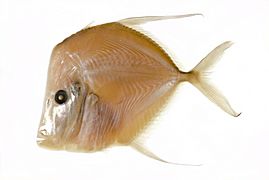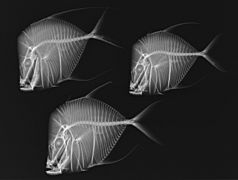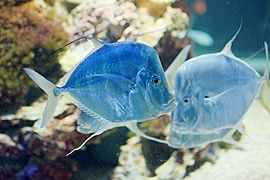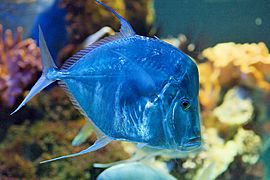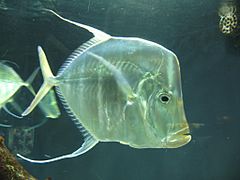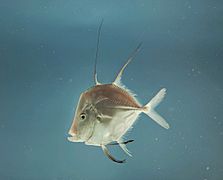Lookdown facts for kids
Quick facts for kids Lookdown |
|
|---|---|
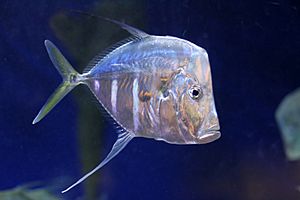 |
|
| Conservation status | |
| Scientific classification | |
| Synonyms | |
|
The lookdown (Selene vomer) is a cool-looking game fish that belongs to the family Carangidae. This family also includes pompanos and jacks. The lookdown was first described in 1758 by a famous scientist named Carl Linnaeus. It gets its name because its eyes are set high on its head, making it look like it's always "looking down."
Contents
What Does the Lookdown Fish Look Like?
The lookdown fish is quite unique! It looks a bit like the Atlantic moonfish, but you can tell them apart by their special fins. The second ray (or "bone") in their dorsal fin (on its back) and anal fin (on its belly) is super long. This makes these fins look like a scythe, which is a curved blade.
The dorsal fin of the lookdown has 9 spines and 23 rays. Its anal fin has 3 spines and 18 rays. Like the Atlantic moonfish, the lookdown has a deep, rhombus-shaped body that is flat from side to side. Its mouth is set low on its head, and its eyes are high up. The front of its head has a noticeable curved-in (concave) shape.
The caudal fin (tail fin) of the lookdown is forked, just like the pompanos. Its pectoral fin (side fin) is also scythe-shaped and reaches about halfway along its second dorsal fin.
Lookdown fish are shiny and silver on both sides, with a slightly darker color on top. Young lookdown fish have a few faint vertical stripes, but these fade away as they grow older. The longest lookdown ever found was about 48.3 centimeters (19 inches) long. The heaviest one weighed about 2.1 kilograms (4.6 pounds).
Where Do Lookdown Fish Live?
In the western Atlantic Ocean, you can find the lookdown fish from Canada and Maine all the way south to Uruguay. This area includes places like Bermuda and the Gulf of Mexico. Even though they are common in warm Atlantic waters, they are rarely seen around the Greater Antilles islands.
Lookdown fish live in both marine (salty ocean) water and brackish water (a mix of fresh and salty water). They can be found at depths from 1 to 53 meters (about 3 to 174 feet). They prefer shallow waters near the coast, often over hard or sandy bottoms. Young lookdown fish might even be seen in estuaries (where rivers meet the sea) or close to sandy beaches.
These fish often swim together in large groups called shoals. However, they can also break off into smaller groups or even just pairs.
Why Are Lookdown Fish Important?
The lookdown fish is not a major fish for commercial fishing. This means it's not caught in large numbers to be sold in stores. However, it is very popular for large public aquariums. People love to see them because of their interesting shape and shiny, eye-catching appearance.
Gallery
See also
 In Spanish: Jorobado de penacho para niños
In Spanish: Jorobado de penacho para niños



